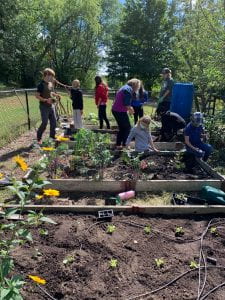Lillian Moller Gilbreth was born on May 24, 1878, in Oakland, California. She was born into a high-class family, and her mother had expectations for her to have a life of domesticity. She had no want for that life. Lillian’s mother said a woman should only be in the newspaper three times, births, marriage, and death. But Lillian wanted to have an education. She went to the University of California, Berkeley and in 1902 she got her master’s degree. After Berkeley, Lillian decided to go to Columbia University, and they rejected him. After she got rejected she met Edward Thorndike, he focused on the worker’s environment, and the rest of her studies were based on that idea. In 1909 Lillian’s husband Frank Bunker Moller who also studied Scientific Management but focused on the time and motion, her children, and Lillian moved to New Jersey to work with the industrial engineer Frederick Winslow Taylor, the “Father of Scientific Management. Frank and Lillian worked on their theory for years, and because she was a woman she was known as the assistant, even though Lillian did most of the work. By 1910 they opened their own consulting practice, they also wrote many books about their theories, but only sometimes Lillian was shown as an author. When she was, she was only shown as L. M. Gilbreth so no one knew she was a woman. Lillian and Frank invented the Therbligs, which is this belief where every activity that goes on is a combination of 17 actions. Lillian had gotten public recognition in 1921 when she became the first honorary member of the Society of Industrial engineers. Many companies made contracts with them but when Frank died on June 14, 1924, they all were canceled, because no one wanted to listen to a woman. After that, Lillian had to reinvent herself. So she thought of helping a woman in her workplace, the home, so they could spend more time doing other things that they want to do. Lillian invented some things that you probably use all the time, such as the L-shaped kitchen, refrigerator shelves, the trash can pedal, the electric food blender, egg holder, butter tray, wastewater hose, the clothes washer (not the laundry machine). She also improved the can opener. From 1935 to 1948 Lillian was the first female professor at Purdue University’s School of Engineering. she retired in 1968 at age 90 sending all her 12 children to college. On January 2, 1972, she Died.
 r the biome project. When Shane found out I was doing the Tullamore she got excited, because her dog’s name is also Tullamore. Tullamore’s scientific name is Xpl-93. The Tullamore Lion is also known as the Desert Lions.
r the biome project. When Shane found out I was doing the Tullamore she got excited, because her dog’s name is also Tullamore. Tullamore’s scientific name is Xpl-93. The Tullamore Lion is also known as the Desert Lions.
 The last few days the sixth grade class was gardening. The first day we cleaned. Emma and I cleaned and organized the hoop house and everyone else weeded the outside beds. The second day we split the beds into seeds and starts (which are plants that have started to grow) . We also got split up into partners, my partner was Maddy. At first I didn’t realize we were partnered and I was working with the Group then Shane told me to work with Maddy. Me and Maddy worked on lettuce starts. We also worked on food webs. We played this food chain game. Where we would draw cards of the food chain. We would have to build up the food web from the first to the fifth stage. We also learned about Abiotic and Biotic. The meaning of Abiotic is non living such as water, soil, air, light, and minerals. The meaning of Biotic is living such as plants, animals, fungus, bacteria, and protist. Biotic is in the food web. The order of the food web is primary producer, primary consumers, secondary consumers, tertiary consumers, and then quaternary consumers.
The last few days the sixth grade class was gardening. The first day we cleaned. Emma and I cleaned and organized the hoop house and everyone else weeded the outside beds. The second day we split the beds into seeds and starts (which are plants that have started to grow) . We also got split up into partners, my partner was Maddy. At first I didn’t realize we were partnered and I was working with the Group then Shane told me to work with Maddy. Me and Maddy worked on lettuce starts. We also worked on food webs. We played this food chain game. Where we would draw cards of the food chain. We would have to build up the food web from the first to the fifth stage. We also learned about Abiotic and Biotic. The meaning of Abiotic is non living such as water, soil, air, light, and minerals. The meaning of Biotic is living such as plants, animals, fungus, bacteria, and protist. Biotic is in the food web. The order of the food web is primary producer, primary consumers, secondary consumers, tertiary consumers, and then quaternary consumers. 